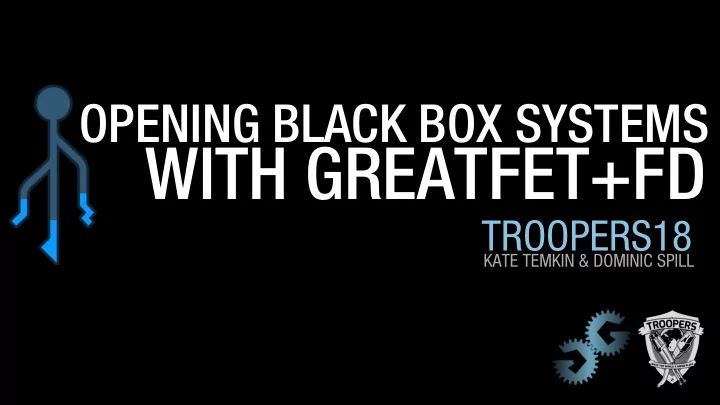

OPENING BLACK BOX SYSTEMS WITH GREATFET+FD TROOPERS18 KATE TEMKIN & DOMINIC SPILL
WHO WE ARE Kate Temkin (@ktemkin): Dominic Spill (@dominicgs): • slayer of Tegras, destroyer of worlds • cannot stop being extraordinary, on penalty of deportation • glitch witch & tool-builder • shark whisperer & demo dancer • educational (reverse) engineer
MANY THANKS TO • Travis Goodspeed (@travisgoodspeed) • Sergey Bratus (@sergeybratus) • Michael Ossmann (@michaelossmann) PEOPLE WHO GIVE US MONEY • Great Scott Gadgets (@gsglabs)
Why target USB? USB is everywhere .
WHY USB? The capability to monitor, MITM, & emulate USB devices enables: Understanding the behaviors of USB and driver stacks ● Building tools that work with existing hardware / software ● Building implants and tools for playing NSA . ● One to get a foot in the door for understanding black box systems. ●
WHY PROXY? All too often-- as with black box systems-- we don’t control the host software stack: Game consoles [e.g. the Nintendo Switch] ● In car entertainment [e.g. Tesla consoles] ● Point of sale ● Televisions ● … pretty much any embedded device that can act as a USB host! ●
USBPROXY NOUVEAU USBProxy is a tool that allows us to proxy the connection between a USB host and device. While proxying a connection we can: Log USB packets (cheap protocol analysis) ● Modify data being sent to or received from a device ● Inject new packets into the connection, or absorb packets ● capture side-channel information and precisely time glitching attacks ● Original version was based on a BeagleBone Black in C++. We’ve rewritten it to take advantage of FaceDancer’s more granular control.
[let’s monitor some USB] https://github.com/ktemkin/Facedancer/blob/master/facedancer-usbproxy.py
USB CLASSES In addition to specifying the standard protocol used for enumeration/configuration, the specs also specify protocols for standard device classes , allowing e.g. operating systems to provide standardized drivers . Human Interface Device (keyboards, mice, datagloves; the usual) ● Serial (e.g. CDC-ACM) ● Mass storage (UMS bulk only / UAS) ● Audio / Video ● Midi ● Scanners ● Networking ● etc. ●
[let’s slack off] https://github.com/ktemkin/Facedancer/blob/master/usbproxy-switch-invertx.py
EXPLORATORY RE There are many USB hosts and devices for which firmware isn’t easily available-- but we don’t always need firmware to do interesting things to a system. Can we discover behaviour? ● Find firmware functions? ● What about identifying hosts? ●
EXPLORING FUNCTIONALITY By monitoring and modifying USB packets we can discover functionality of a host system Does it take firmware updates via USB? ● What filename is it looking for? ○ Does it read that file multiple times? ○ How does the host enumerate the device? ● Order and length of requests ○ Timing ○ Windows Compatibility ID ○ umap2 already does this, let’s port it to new FaceDancer ○
EXPLORING FUNCTIONALITY By monitoring and modifying USB packets we can discover functionality of a host system Does it take firmware updates via USB? ● What filename is it looking for? ○ Does it read that file multiple times? ○ How does the host enumerate the device? ● Order and length of requests ○ Timing ○ Windows Compatibility ID ○ umap2 already does this; let’s port it to new FaceDancer ○ What are the device’s access patterns? ●
[let’s run a simulated firmware update]
UMS DOUBLE FETCH Of course, nothing says our emulated devices have to behave nicely. Example: most systems assume that disk contents don’t change on their own Reality: in practice, they totally can Example firmware update sequence: USB host reads firmware off flash drive, computing a checksum as it does ● USB host verifies the checksum, which passes ● USB host rereads the firmware and flashes it to ROM ●
[let’s fetch... twice ] https://github.com/ktemkin/Facedancer/blob/master/facedancer-ums-doublefetch.py
EXPLORING FUNCTIONALITY By monitoring and modifying USB packets we can discover functionality of a host system Does it take firmware updates via USB? ● What filename is it looking for? ○ Does it read that file multiple times? ○ How does the host enumerate the device? ● Order and length of requests ○ Timing ○ Windows Compatibility ID ○ umap2 already does this, let’s port it to new FaceDancer ○
[let’s talk about firmware filenames]
GlitchKit Synchronization Stimulus Triggering Features Features Generation USB Host Simple Event Triggers Event Routing USB Device UART Triggers eMMC Device Clock Management Trigger Output (not yet complete)
GLITCHKIT LIBRARY gf = GreatFET() gf.switch_to_external_clock() gf.glitchkit.provide_target_clock(VBUS_ENABLED); gf.glitchkit.simple.watch_for_event( 1, [('EDGE_RISING', 'J1_P7')]) gf.glitchkit.use_events_for_synchronization(COUNT_REACHED) gf.glitchkit.trigger_on_events(HOST_SETUP_TRANSFER_QUEUED) gf.glitchkit.usb.capture_control_in(request=GET_DESCRIPTOR, value=GET_DEVICE_DESCRIPTOR, length=18)
QUESTIONS ? THANKS FOR LISTENING! JOIN US: https://github.com/greatscottgadgets/greatfet https://github.com/ktemkin/Facedancer https://github.com/glitchkit
Recommend
More recommend